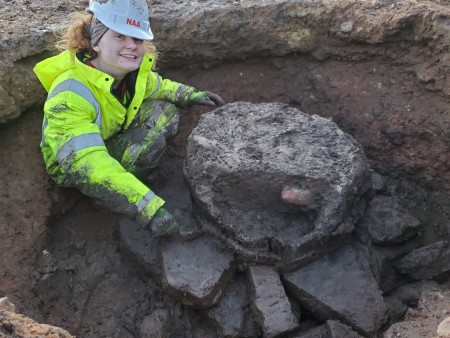Publish date: 21 February 2022
Berwick barrel causes a stink while wall raises questions about town’s past

The archaeological dig at Berwick Infirmary continues to reveal some fascinating finds, with one raising questions about the town’s past and the other causing a bit of a stink.
The excavation, which is taking place as part of the £30million project by Northumbria Healthcare NHS Foundation Trust to build a state-of-the-art new hospital, has already revealed a number of finds related to Berwick’s medieval history, including pottery and a well which contained the nearly complete remains of a pony or donkey.
In recent weeks, the dig, which is being carried out by Northern Archaeological Associates, part of Ecus Archaeology, has also revealed new evidence relating to the town’s medieval fortifications…and a toilet.
According to site supervisor Holly Drinkwater, this barrel latrine was made of wooden planks bound together with twisted hazel, and was likely originally used to store foodstuffs before being repurposed as a latrine.
The waterlogged conditions on the site meant that the wooden structure of the barrel (and its rather ripe contents) had remained well preserved over the intervening centuries.
The barrel was carefully excavated, packed and wrapped in cling film before being sent to the York Archaeological Trust, where it is hoped the wood can be preserved and the barrel restored to its former glory.
Holly added: “The contents of the latrine will be subject to environmental analysis to assess the presence of seeds, grains and intestinal parasites. These environmental remains are a goldmine for archaeologists for reconstructing past diets and will be able to tell us a great deal about the eating habits and hygiene of the residents of medieval Berwick.”
However, perhaps the most significant remains encountered so far are the foundations of a four-metre-wide defensive wall alongside a 12-metre-wide by two-metre-deep ditch.
Berwick’s history of changing hands between England and Scotland is well known and the huge Elizabethan walls that remain a key feature in the town to this day are clearly understood based on their physical remains and historical records. However, the newly discovered wall and ditch have been described as ‘completely unexpected’.
Site supervisor Craig Parkinson said: “They seem similar in construction to the earlier town defences, but face the wrong direction to be obviously associated with them. The alignment makes more sense as part of an outer wall of the castle, but they are much further away than would be expected if that were the case.
“Are they part of either of these, do they relate somehow to the later fortifications or do they represent a phase of Berwick’s development that we were previously unaware of?
“Only a short section of wall has been uncovered so far, and unfortunately much of it seems to have been removed during earlier hospital development in the 1970s, a time when less concern was given to the preservation and recording of historic remains.”
It is hoped that further excavation work will reveal more and better-preserved sections of the wall which will help answer some of the questions that have been raised so far.
Meanwhile, demolition work continues to take place as part of the project to develop a new hospital for communities in Berwick and beyond. Originally built in 1874, the current infirmary is no longer suitable for the efficient delivery of modern-day healthcare.
The new purpose-built hospital will re-provide all the existing services, with the addition of an accredited endoscopy suite to deliver care closer to people’s homes, as well as housing GP practice Well Close Medical Group.
Ben O’Connell, media and communications officer, Northumbria Healthcare
Benjamin.O’Connell@northumbria-healthcare.nhs.uk or 07833 046680.
